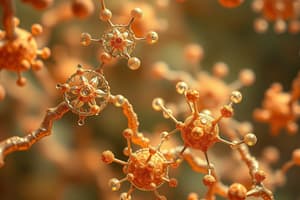Podcast
Questions and Answers
Which enzyme condenses oxaloacetate with acetyl-CoA to form citrate in the citric acid cycle?
Which enzyme condenses oxaloacetate with acetyl-CoA to form citrate in the citric acid cycle?
- Aconitase
- Pyruvate dehydrogenase
- ATP-citrate lyase
- Citrate synthase (correct)
What is the main function of the citric acid cycle?
What is the main function of the citric acid cycle?
- Synthesize fatty acids
- Oxidize acetyl-CoA to CO2 (correct)
- Produce ATP from glucose
- Convert pyruvate to lactate
Which process links glycolysis with the citric acid cycle?
Which process links glycolysis with the citric acid cycle?
- Oxidative decarboxylation of pyruvate to acetyl-CoA (correct)
- Isomerization of citrate to isocitrate
- Conversion of succinyl-CoA to succinate
- Formation of alpha-ketoglutarate from isocitrate
What is the amphibolic role of the citric acid cycle?
What is the amphibolic role of the citric acid cycle?
Where are all the enzymes of the citric acid cycle located?
Where are all the enzymes of the citric acid cycle located?
Which enzyme is responsible for the irreversible hydrolysis of the thioester bond in acetyl-CoA?
Which enzyme is responsible for the irreversible hydrolysis of the thioester bond in acetyl-CoA?
Which enzyme catalyzes the formation of succinyl-CoA, an irreversible step in the citric acid cycle?
Which enzyme catalyzes the formation of succinyl-CoA, an irreversible step in the citric acid cycle?
Which enzyme is responsible for the isomerization of citrate to isocitrate in the citric acid cycle?
Which enzyme is responsible for the isomerization of citrate to isocitrate in the citric acid cycle?
Which enzyme complex in the citric acid cycle is similar to the pyruvate dehydrogenase complex?
Which enzyme complex in the citric acid cycle is similar to the pyruvate dehydrogenase complex?
Which molecule is liberated during the conversion of isocitrate to alpha ketoglutarate in the citric acid cycle?
Which molecule is liberated during the conversion of isocitrate to alpha ketoglutarate in the citric acid cycle?
Malate is formed from fumarate by the enzyme
Malate is formed from fumarate by the enzyme
Malate is oxidized to oxaloacetate by the enzyme
Malate is oxidized to oxaloacetate by the enzyme
During the citric acid cycle, two carbon dioxide molecules are removed in the following reactions: A. Step 3, oxalosuccinate to alpha ketoglutarate B. Step 4, ______
During the citric acid cycle, two carbon dioxide molecules are removed in the following reactions: A. Step 3, oxalosuccinate to alpha ketoglutarate B. Step 4, ______
Oxaloacetate may be viewed as a catalyst, which enters into the reaction, causes complete oxidation of acetyl- CoA and comes out of it without any change. Oxalo-acetate is an important junction point in
Oxaloacetate may be viewed as a catalyst, which enters into the reaction, causes complete oxidation of acetyl- CoA and comes out of it without any change. Oxalo-acetate is an important junction point in
The succinate dehydrogenase is competitively inhibited by
The succinate dehydrogenase is competitively inhibited by
Flashcards are hidden until you start studying
Study Notes
Citric Acid Cycle
- The enzyme citrate synthase condenses oxaloacetate with acetyl-CoA to form citrate in the citric acid cycle.
Function of Citric Acid Cycle
- The main function of the citric acid cycle is to generate energy for the cell through the breakdown of acetyl-CoA derived from carbohydrates, fats, and proteins.
Linking Glycolysis with Citric Acid Cycle
- The process that links glycolysis with the citric acid cycle is the conversion of pyruvate to acetyl-CoA.
Amphibolic Role of Citric Acid Cycle
- The citric acid cycle plays an amphibolic role, meaning it is involved in both catabolic and anabolic processes.
Location of Citric Acid Cycle Enzymes
- All the enzymes of the citric acid cycle are located in the mitochondrial matrix.
Enzymes of Citric Acid Cycle
- The enzyme acetyl-CoA synthetase is responsible for the irreversible hydrolysis of the thioester bond in acetyl-CoA.
- The enzyme α-ketoglutarate dehydrogenase catalyzes the formation of succinyl-CoA, an irreversible step in the citric acid cycle.
- The enzyme aconitase is responsible for the isomerization of citrate to isocitrate in the citric acid cycle.
- The enzyme complex α-ketoglutarate dehydrogenase in the citric acid cycle is similar to the pyruvate dehydrogenase complex.
Citric Acid Cycle Reactions
- During the citric acid cycle, two carbon dioxide molecules are removed in the reactions: Step 3, oxalosuccinate to alpha-ketoglutarate and Step 4, isocitrate to alpha-ketoglutarate.
Importance of Oxaloacetate
- Oxaloacetate may be viewed as a catalyst, which enters into the reaction, causes complete oxidation of acetyl-CoA and comes out of it without any change.
- Oxaloacetate is an important junction point in carbohydrate, fat, and protein metabolism.
Inhibition of Succinate Dehydrogenase
- The succinate dehydrogenase is competitively inhibited by malonate.
Conversion of Fumarate to Malate and Oxaloacetate
- Malate is formed from fumarate by the enzyme fumarase.
- Malate is oxidized to oxaloacetate by the enzyme malate dehydrogenase.
Studying That Suits You
Use AI to generate personalized quizzes and flashcards to suit your learning preferences.




